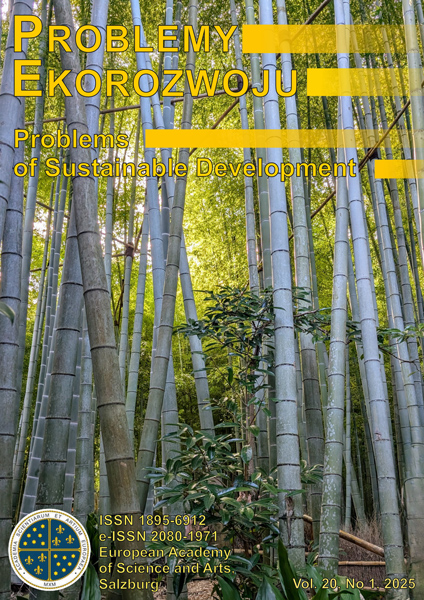Czy integracja obszarów miejsko-wiejskich prowadzi do ograniczenia energochłonności? Przykład Chin
Shuxing Chen
Southwestern University of Finance and Economics, Chengdu (Chiny)
Renzhong Ding
Southwestern University of Finance and Economics, Chengdu (Chiny)
Biao Li
Southwestern University of Finance and Economics, Chengdu (Chiny)
Abstrakt
W artykule przeanalizowano matematyczną zależność integracji obszarów miejsko-wiejskich i energochłonności opartej na funkcji produkcyjnej z uwzględnieniem kapitału, rynku pracy i energii. Jest to podstawą do analizy empirycznej odnoszącej się do tego, jak integracja wpływa na energochłonność, na bazie statycznych i dynamicznych paneli odnoszących się do 30 regionów w Chinach, uwzględniając dane z lat 2005-2014 i używając metod szacowania FE, IV-FE, IV-GMM i MG. Jako części procesu integracji, na podstawie danych empirycznych, wyróżniliśmy urbanizację, industrializację i stronę technologiczną. Okazało się, że po pierwsze urbanizacja może znacząco obniżyć energochłonność w krótkiej perspektywie czasowej, jednak korzyści pojawiają się po dłuższym czasie, ponieważ Chiny nie przywiązywały roli do oszczędzania energii w kontekście urbanizacji. Po drugie, industrializacja może efektywnie obniżyć energochłonność wykorzystywanych technologii i to zarówno w perspektywie krótko, jak i długoterminowej.
Słowa kluczowe:
integracja obszarów miejsko-wiejskich, urbanizacja, industrializacja, technologia, energochłonnośćBibliografia
ALLEN B., XUN Wu, 1999, Foreign direct investment in China’s power sector: trends, benefits and barriers, in: Energy Policy, 1999. 27(12), p. 695-711.
Google Scholar
ANTONOPOULOS C., SAKELLARIS P., 2009, The contribution of Information and Communication Technology investments to Greek economic growth: An analytical growth accounting framework, in: Information Economics and Policy, 21(3), p. 171-191.
Google Scholar
ARELLANO M., BOND S., 1991, Some tests of specification for panel data: Monte Carlo evidence and an application to employment equations, in: Review of Economic Studies, 58, p. 277-97.
Google Scholar
EDENHOFER O. et al., 1998, Power Shifts: The Dynamics of Energy Efficiency, in: Energy Economics, 20, p. 513-537.
Google Scholar
FISH-VANDEN, JEFFERSON K., 2006, What Is Driving China’s Decline in Energy Intensity?, in: Resource and Energy Economics, 7(26), p. 7-97.
Google Scholar
GARBACCIO R.F. et al., 1999, Why has the Energy-Output Ratio Fallen in China?, in: Energy Journal, 20(3), p. 63-91.
Google Scholar
HANSON G.H., 2005, Market Potential, Increasing Returns, and Geographic Concentration, in: Journal of International Economics, 67(1), p. 1-24.
Google Scholar
HENDERSON J.V., 1986, Efficiency of Resource Usage and City Size, in: Journal of Urban Economics, 19(1): p. 47-70.
Google Scholar
HENRYSON J. et al., 2000, Energy Efficiency in Buildings Through Information-Swedish Perspective, in: Energy Policy, 23, p. 169-180.
Google Scholar
JACOBS J., 1969, The Economy of Cities, Random House, New York, p. 116-127.
Google Scholar
JAFFE A. et al., 1993, Geographic Localization of Knowledge Spillovers as Evidenced by Patent Citations, in: Quarterly Journal of Economic, 108(3), p. 577-598.
Google Scholar
JONES D.W., 1989, Urbanization and energy use in economic development, in: Energy Journal, 10, p. 29-44.
Google Scholar
KHAZZOM J.D., 1980, Economic Implication of Mandated Efficiency Standards for Household Appliances, in: Energy Journal, 1, p. 21-39.
Google Scholar
KAMBARA T., 1992, The Energy Situation in China, in: The China Quarterly, 131, p. 608-636.
Google Scholar
MARTINEZ-ZARZOSO I., MARUOTTI A., 2011, The impact of urbanization on CO2 emissions: Evidence from developing countries, in: Ecological Economics, 70, p. 1344-1353.
Google Scholar
NICKELL S., 1981, Biases in dynamic models with fixed effects, in: Econometrica, 49(6), p. 1417-1426.
Google Scholar
OTAVIA M., JOSLE G., 2002, Foreign Direct Investment and Decoupling Between Energy and Gross Domestic Product in Developing Countries, in: Energy Policy, 30, p. 87-89.
Google Scholar
PENEDDER M., 2002, Structural Change and Aggregate Growth, WIFO (The Austrian Institute of Economic Research) Working Paper.
Google Scholar
PESARAN M.H., 2006, Estimation and tecerence in large heterogeneous panels with a multifactor error structure, in: Econometrica, 74, p. 967-1012.
Google Scholar
PESARAN M.H., SMITH R., 1995, Estimating long-run relationships from dynamic heterogeneous panels, in: Journal of econometrics, 68(1), p. 79-113.
Google Scholar
PESARAN M.H., SHIN Y., SMITR R.P., 1999, Pooled mean group estimation of dynamic heterogeneous panels, in: Journal of the American Statistical Association, 94(446), p. 621-634.
Google Scholar
RICHARD G., ADAM B., 1999, The Induced Innovation Hypothesis and Energy- saving Technological Change, in: Quarterly Journal of Economics, 114(3), p. 941-975.
Google Scholar
SAMUELS et al., 1984, Potential Production of Energy cane for Fuel in the Caribben, in: Energy Progress, 4, p. 249-251.
Google Scholar
SADORSKY P., 2013, Do urbanization and industrialization affect energy intensity in developing countries?, in: Energy Economics, 37, p. 52-59.
Google Scholar
SADORSKY P., 2014, The Effect of Urbanization and Industrialization on Energy Use in Emerging Economies: Implications for Sustainable Development, in: American Journal of Economics and Sociology, 73(2), p. 392-409.
Google Scholar
VU K. M., 2015, ICT as a source of economic growth in the information age: Empirical evidence from the 1996-2005 period, in: Telecommunications Policy, 35, p. 357-372.
Google Scholar
WELFENS P.J.J., 2002, Interneteconomics.net: macroeconomics, deregulation, and innovation, Springer, New York, p. 78-110.
Google Scholar
WEI B. R. et al., 2003, Urbanization impaction energy demand and CO2 emission in China, in: Journal of Chongqing University-Eng. Ed, 2(10), p. 46-50.
Google Scholar
ZHANG H. , BEHRMAN J.R., FAN C., WEI X., ZHANG J., 2014, Does Parental Absence Reduce Cognitive Achievements? Evidence from Rural China, in: Journal of Development Economics, 111, p. 181-195.
Google Scholar
Autorzy
Shuxing ChenSouthwestern University of Finance and Economics, Chengdu Chiny
Autorzy
Renzhong DingSouthwestern University of Finance and Economics, Chengdu Chiny
Autorzy
Biao LiSouthwestern University of Finance and Economics, Chengdu Chiny
Statystyki
Abstract views: 15PDF downloads: 5
Licencja

Utwór dostępny jest na licencji Creative Commons Uznanie autorstwa – Na tych samych warunkach 4.0 Miedzynarodowe.




